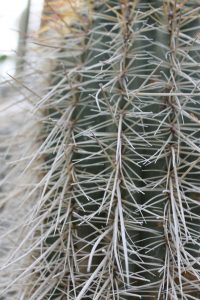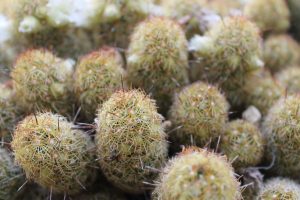By Andy Winfield

Cacti are interesting plants and a bit strange; some look like they could hoik themselves out of the ground and lumber around with spiny arms flailing, and others like they’ve just landed, and a door will slowly hiss open unleashing a thousand tiny aliens. They used to be something we only saw in Western movies, an indication of an arid landscape, usually accompanied by a lone rider with chapped lips shielding eyes from the sun. There’s been a resurgence in recent times, a lot of care and love is being heaped on these fascinating and unusual plants in houses around the country. It’s about time they received the attention they deserve; they’re one of the plant world’s many success stories, settling comfortably in the harshest environments with ingenious adaptations.
All plants need air, water, light, and nutrients to survive; the earth, is a vast and diverse interlocking jigsaw puzzle of habitats and micro habitats. Plants have found ingenious adaptations to make use of the available necessities and preserve the Modus Operandi; cacti are an excellent example of this. There are over 1,750 species of cacti, in all shapes and sizes: columnar, globular, climbers, and tree like. One thing that they have in common, is that they have all adapted to an extreme environmental conundrum. The habitats where they live are intense; the hot and dry days followed by cold nights followed by the heat and the dry, and so it goes. No plant in their right mind would live here. Over the course of millions of years, cacti have adapted ways to cope.
 All cacti have areoles; an areole is a branch that is stunted to such a degree that they just look like small rises on the stem. Protruding from these areoles are thick spikes; these spikes are modified leaves, an adaptation that enables the plant to protect itself. The flowers also spring forth from the areole, raised high above the spikes for moths, bees, and bats. So, if branches are areoles and spines are leaves, how does the plant photosynthesise? Where a plant is green, there is probably food production going on, and cacti use their highly developed stem for using light and air to make food. Usually and leaf will have stomata for regulating gasses, on cacti they are sunken in the stem and only open at night when the air is cooler. Another stem adaptation is its corrugation; the dips and folds of a cactus serve a special purpose. After heavy seasonal rain the cacti gather as much water as they can and swell up; they store all the excess in succulent tissue, saving it for a (non) rainy day. The roots that gather this water are shallow, not extending too deep into the ground; they do however travel widely, fanning out around the plant. A plant’s roots will go where the water is, and in a desert is sticks to the surface.
All cacti have areoles; an areole is a branch that is stunted to such a degree that they just look like small rises on the stem. Protruding from these areoles are thick spikes; these spikes are modified leaves, an adaptation that enables the plant to protect itself. The flowers also spring forth from the areole, raised high above the spikes for moths, bees, and bats. So, if branches are areoles and spines are leaves, how does the plant photosynthesise? Where a plant is green, there is probably food production going on, and cacti use their highly developed stem for using light and air to make food. Usually and leaf will have stomata for regulating gasses, on cacti they are sunken in the stem and only open at night when the air is cooler. Another stem adaptation is its corrugation; the dips and folds of a cactus serve a special purpose. After heavy seasonal rain the cacti gather as much water as they can and swell up; they store all the excess in succulent tissue, saving it for a (non) rainy day. The roots that gather this water are shallow, not extending too deep into the ground; they do however travel widely, fanning out around the plant. A plant’s roots will go where the water is, and in a desert is sticks to the surface.
Every part of a cactus has adapted to its environment. This is one of the reasons why plants are so interesting and profoundly magnificent; plants can’t move around taking advantage of the changing seasons, they can’t live a nomadic life, they can’t seasonally migrate. They, for the most part, sit in a region and over time modify themselves so they are perfectly suited to the habitat around them. Branches become areoles and leaves become spines and stems become food producers. These adaptations exist throughout the plant world, just look at a plant and ask, ‘why is that bit like that?’, and more often than not, the answer will enthral you.

